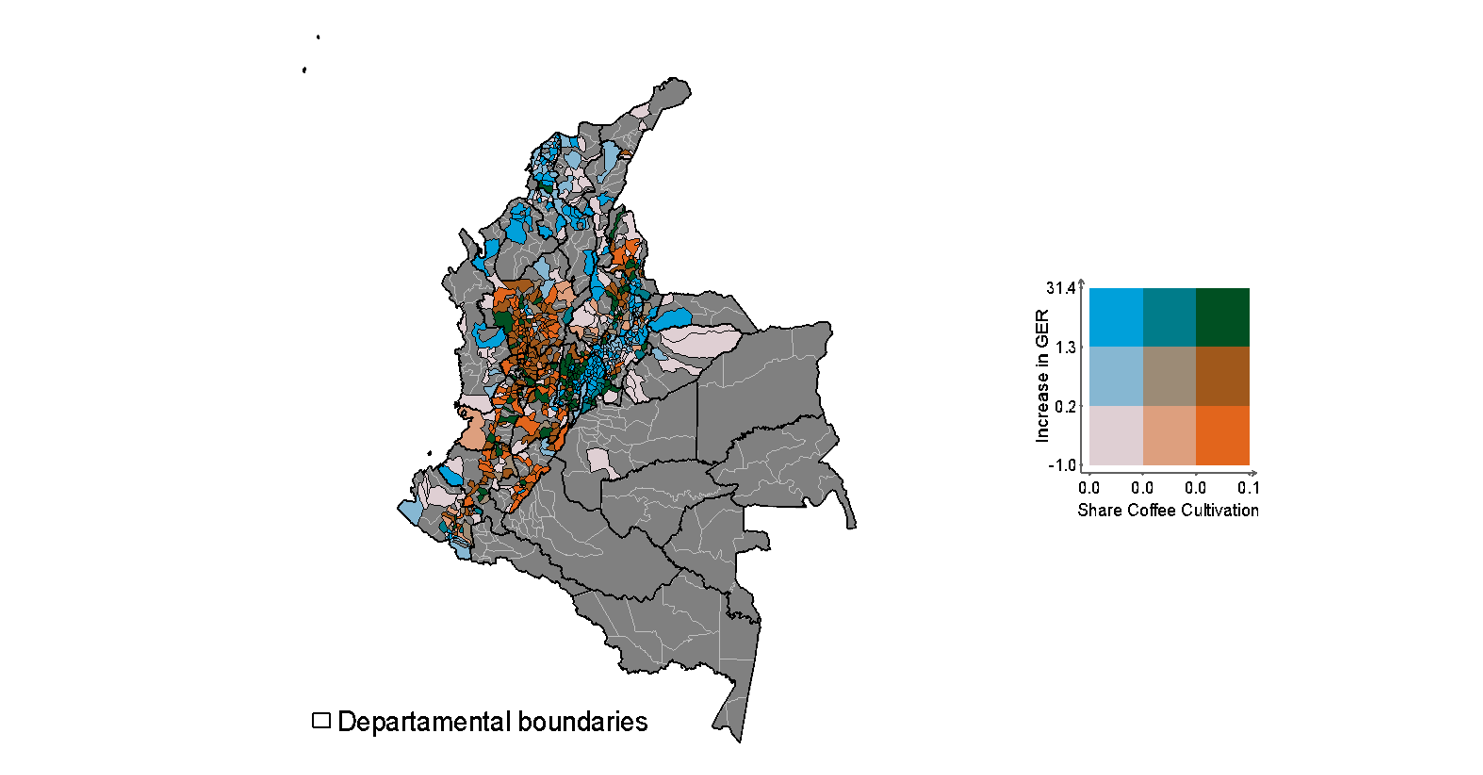
Commodity specialisation in Colombia during the late 19th and 20th centuries had negative impacts on the demand for education during a surge in global demand for coffee
The global economy is facing a boom in demand for minerals essential to the adoption of renewable energy technologies, including cobalt, lithium, copper, and coltan. However, despite the undeniable benefits of implementing environmentally friendly solutions, these minerals are mainly extracted in settings of extreme poverty, leading to one of the most disgraceful problems of our time – the persistence of child labour in countries characterised by socioeconomic deprivation and the potential for specialisation in commodities.
Around one million children worldwide are employed in the artisanal and small-scale mining of minerals, much of them necessary for eco-friendly technologies (ILO 2019, O’Driscoll 2017). In the Democratic Republic of the Congo (DRC), which is the source of approximately 50% of global cobalt production (O’Driscoll 2017), close to 200,000 children work in mines, subjecting them to harsh conditions and impeding their physical, social, emotional, and educational development (Schipper et al. 2015 quoted in O’Driscoll 2017, Rozani 2022).
Educational outcomes and commodity booms in the context of poverty
Education is undeniably one of the aspects impacted by commercial booms in low-income and commodity-based economies. Existing literature reveals how the confluence of impoverished settings, the potential for commodity specialisation, and global booms in demand for natural resources, has repercussions on demand for education. Driven by the need to contribute economically to their low-income households, children often find themselves compelled to work in the commodity sector, sacrificing their schooling in the process.
In this context, Santos (2014) provides insights into how children in Colombia responded to the international gold boom by increasing their engagement in work, thereby decreasing school attendance and hindering the expected accumulation of human capital. Similarly, Human Rights Watch (2015) reports that Filipino children involved in mineral extraction often skip school or drop out altogether.
Importantly, the hindrance to schooling extends beyond mineral resources. Scholars such as Dammert (2008), Edmonds and Pavcnik (2005), and Kruger (2007) associate the adverse consequences of commodity specialisation and poverty with agrarian products. For example, Kruger (2007) shows how the increase in coffee production in Brazil led to the abandonment of schools by poorer children, while Dammert (2008) found similar outcomes, this time linked to the illegal production of coca in Peru.
A long-term economic issue
The impact of commodity specialisation on the demand for education is a longstanding concern in economics. By studying historical evidence on the commodity specialisation of Latin American countries during the late 19th and 20th centuries, our research (see Fuentes-Vásquez and España-Eljaiek 2023) sheds light on this important issue.
We attempt to disentangle key lessons by exploring Colombia's historical specialisation in coffee. Colombia was an impoverished country 150 years ago, but the increasing global demand for coffee presented an opportunity to ramp up coffee production. This changed the structure of the Colombian economy, with coffee going from representing approximately 16% of Colombian exports in the 1880s to some 75% in the 1940s (Ocampo 2010, Urrutia Montoya et al. 2002). This agrarian commodity boom not only facilitated the modernisation of the economy but also provided resources, many of which were invested in moving towards mass schooling (Ramírez and Téllez 2007).
However, prosperity came with a price. Specifically, we find that the coffee economy had adverse effects on the demand for schooling by hindering the enrolment of children in schools in coffee production areas. To uncover this, we created a unique database at the municipal level spanning different periods of the coffee production boom between the late 19th and 20th centuries, by gathering data on coffee, plantation sizes, primary enrolment rates, and socio-economic factors. Using instrumental variable and panel data regressions, our evidence shows that municipalities with higher coffee production levels had lower primary enrollment rates for pupils aged 7 to 14. Moreover, the results also indicate that specialisation in coffee-growing lowers enrollment rates more than other agricultural activities, probably because, unlike other agrarian goods, the coffee economy involves processes of cultivation and transformation suitable for children's physical constitution.
Figure 1 graphically illustrates the existent relationship between coffee production and education. In particular, it depicts the relationship between the increase in gross enrollment rates between 1910 and 1938 and the local share of coffee production. The figure first shows that areas with a high share of coffee cultivation show lower increases in the primary enrolment rates between the analysed periods (orange areas). Second, as mentioned earlier, the figure shows that the negative effects of coffee production seem to be stronger than for other agrarian products, as areas with a lower share of coffee production devoted to other agrarian activities have larger increases in enrollment rates (blue areas).
Figure 1: Increase in Gross Enrolment Rates and share of coffee cultivation in agrarian regions, 1938.

Note: this matrix map considers, on the one hand, the growth rate of the GER between 1910 and 1938, and on the other hand, the percentage of land dedicated to agricultural production of all sorts. The orange colour indicates the percentage of land dedicated to coffee production close to 100% and a low growth of the GER; the blue colour indicates the opposite.
Lessons from the past and present
A century ago, Latin American economies prioritised economic prosperity driven by global demand for their natural resources. While some countries translated these benefits into improved schooling outcomes (Bértola and Ocampo 2013), others, like Colombia, failed to recognise that the economic boom could come at the cost of depressing the demand for education, with implications for the accumulation of future human capital (see Carrillo 2019).
Current evidence shows that commodity booms should be accompanied by policies mitigating their social costs. For example, Human Rights Watch (2015) suggests that low-income, commodity-based economies should implement policies to reduce school absenteeism, such as free school meals, social support programs, or compulsory free education. Parker and Vogl (2018) and Attanasio, Cattan and Krutikova (2017) also shed some light on the importance of Conditional Cash Transfers (CCTs). In other words, as de Walque and Valente (2023) suggest, these programmes aim to alleviate the opportunity costs to parents of sending their children to school, thus removing the propensity to reduce the demand for schooling. Importantly, de Walque and Valente (2023) argue how critical it is to focus not only on policies directed at the parents but also to incentivise children with low-cost interventions, such as direct transfers to children by using a system of vouchers.
Our analysis emphasises the importance of learning from both the past and the present. A hundred years ago, disadvantaged Colombian children paid the price for the country’s specialisation in commodity production. Now this price is being paid by vulnerable children in Mozambique, the DRC, the Philippines, and many other countries with low-income levels affected by the current global demand for natural resources. Given the past and present evidence, work is needed to understand and implement the necessary national and international policies to protect children’s education during commodity booms.
Editors' note: This column is published in collaboration with the International Economic Associations’ Women in Leadership in Economics initiative, which aims to enhance the role of women in economics through research, building partnerships, and amplifying voices.
References
Attanasio, Cattan, and Krutikova (2017), "Early childhood development policies: The evidence and the research agenda. VoxDev." https://voxdev.org/topic/health-education/early-childhood-development-policies-evidence-and-research-agenda.
Bértola, L, and J A Ocampo (2013), "El desarrollo económico de América Latina desde la independencia." Fondo de Cultura Económica.
Carrillo, B (2019), Present Bias and Underinvestment in Education? Long-run Effects of Childhood Exposure to Booms in Colombia. Long-Run Effects of Childhood Exposure to Booms in Colombia.
Dammert, A C (2008), "Child labor and schooling response to changes in coca production in rural Peru." Journal of Development Economics, 86(1): 164–180.
de Walque and Valente (2023), "Incentivising school attendance: Evidence from Mozambique." VoxDev. https://voxdev.org/topic/health-education/incentivising-school-attendance-evidence-mozambique.
Edmonds, E V and N Pavcnik (2005), "Child labor in the global economy." Journal of Economic Perspectives, 19(1): 199–220.
Fuentes-Vásquez, M J and I España-Eljaiek (2023), "Coffee tastes bitter: education and the coffee economy in Colombia in the late nineteenth and early twentieth centuries." European Review of Economic History, 27(2): 174–195.
Human Rights Watch (2015), " What... If Something Went Wrong?: Hazardous Child Labor in Small-scale Gold Mining in the Philippines. Human Rights Watch.
ILO, I. L. O. (2019), Child Labour in Mining and Global Supply Chains.
Kruger, D I (2007), "Coffee production effects on child labor and schooling in rural Brazil." Journal of Development Economics, 82(2): 448–463.
O’Driscoll, D (2017), Overview of child labour in the artisanal and small-scale mining sector in Asia and Africa.
Ocampo, J A (2010), "El sector externo de la economía colombiana en el siglo XIX. In Economía colombiana del siglo XIX (pp. 201–240)." Fondo de Cultura Económica/Banco de la República.
Paker and Vohl (2018), "The long-term effects of cash transfers: Mexico’s Progresa." https://voxdev.org/topic/public-economics/long-term-effects-cash-transfers-mexico-s-progresaVoxDev.
Ramírez, M T and J P Téllez (2007), “La educación primaria y secundaria en Colombia en el siglo XX.” In J. Robinson & M. Urrutia (Eds.), Economia Colombiana del Siglo XX : Un análisis cuantitativo (pp. 459–515). Fondo de Cultura Económica - Banco de la República de Colombia.
Rozani, A S (2022), Child labour in mining in India and the DRC: two case studies. Stellenbosch: Stellenbosch University.
Santos, R J (2014), Not all that glitters is gold: Gold boom, child labor and schooling in colombia.
Urrutia Montoya, Miguel; Pontón Castro, Adriana; Posada Posada, C. E. (2002). El crecimiento económico colombiano en el siglo XX. Banco de la República, Fondo de Cultura Económica.


